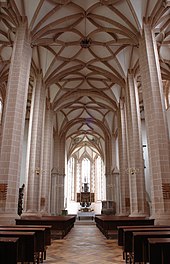Castle Church (Chemnitz)
The Chemnitz Castle Church is located in the Chemnitz district of Schloßchemnitz on the Schloßberg and is considered the most valuable building in the city. It is one of two churches in the St. Petri Castle Parish in the Evangelical Lutheran Regional Church of Saxony .
history
The first church on the site of today's castle church was built in the 12th century, to which the Benedictine monastery was attached to the south . It was consecrated as St. Mary's Church. The abbots Heinrich von Schleinitz and Hilarius von Rehburg had a new church built in the style of a three-aisled, late Gothic hall church through a large-scale renovation . The main foreman was Andreas Günther from the Bohemian Komotau (Chomutov), who completed the renovation in 1523/25. The monastery complex was also rebuilt from 1499 in the Upper Saxon late Gothic style. In 1540 the monastery was dissolved during the Reformation.
In 1945, the castle church suffered bomb damage to the neo-Gothic spire, the roof and the north facade. Despite some resistance, the damaged spire was torn down as a "foreign body in the cityscape" by city officials and replaced by today's, lower degree from 1946 to 1949 as part of the repair work. The interior was restored from 1950 to 1957.
Choir room
The Gothic main altar (Katharinenaltar) was created in 1499 by Pankratius Grueber for the Großenhain Katharinenkirche . It has been on permanent loan in the castle church since 1995. The altarpiece shows images of saints and, above all, scenes from the life and martyrdom of St. Catherine. Above the altar is a figure of the suffering Christ.
The sacrament house is dated to the year 1300. In the vaulted ceiling of the chancel there are frescoes which are dated to 1530. They show the four evangelists . The wall pulpit dates from 1538.
The baroque font with a wooden lid should also be mentioned as an item of equipment . It was created in 1668 and is located in the choir room.
The most important pieces of equipment in the church include two main works by the monogrammist HW ( Hans Witten ?), Who is one of the most important sculptors of the early 16th century in Germany. On the one hand, there is the fully plastic, smaller than life-size group of figures of the flagellation of Christ, which is carved from oak, and on the other hand, the richly designed surround of the north portal of the church.
North portal
On the south side of the nave inside the church is the north portal, which was built 1504–1505 by master Hans Witten and completed in 1525 by Franz Maidburg . It was originally built on the front of the church around the main portal and had to be dismantled in 1973 for conservation reasons and placed in the church interior.
The portal is about eleven meters high and shows a representation of the world redemption, distributed over three levels. The upper level (the divine level) represents the trinity : God the Father on the throne, Christ crucified, on the cross the dove as a symbol of the Holy Spirit, framed by angel figures making music and worshiping. The middle level connects the divine with the worldly and shows Mary with the baby Jesus, the patroness of the monastery church, framed by figures of John the Evangelist and John the Baptist . On the outside are the two saints of the order, St. Benedict and St. Scholastica of Nursia . The lower, secular level contains lion figures, which symbolize the guardianship in front of the sanctuary. There are also figures of the founders of the monastery (Emperor Lothar and his wife Richenza ) as well as two abbots ( Heinrich von Schleinitz and Hilarius von Rehburg ). In the arch of the door there is Eve on a tree stump, opposite to Satan, and under the banner two angels hold the globe as an object of redemption.

organ
The large symphonic-romantic organ of the castle church was built between 2006 and 2011 by the company Orgelbau Vleugels (Hardheim). The instrument is based on organs by the French organ builder Aristide Cavaillé-Coll . It has 48 stops on three manuals and a pedal . The key actions are mechanical, supported by a historical Barker machine for the main work and the manual links to the main work. The stop actions are electric.
|
|
|
|
||||||||||||||||||||||||||||||||||||||||||||||||||||||||||||||||||||||||||||||||||||||||||||||||||||||||||||||||||||||||||||||||||||||||||||||||||||||||||||||||||||||||||||||||||||||||||||||||||||||||||||||||||||
- Coupling normal coupling, sub-octave coupling (III / I, I / I)
- Beside / effect register: Effet d'orage (thunder), Crayon (pencil), Carillon (glockenspiel), E'toile Tournante (Cymbelstern), Rossignol (nightingale), Imber (rain), Timbale (timpani)
- Playing aids : 4000 electronic typesetting system, sequencer

Varia
On January 20, 2019, the cultural radio program of Mitteldeutscher Rundfunk , MDR Kultur , broadcast the Sunday service of the parish with Pastor Christoph Herbst as a direct broadcast.
Web links
Individual evidence
- ^ Anke Neugebauer: Andreas Günther from Komotau. A builder at the turn of the modern age (Hallische Contributions to Art History 11), Bielefeld 2011, pp. 23–36
- ↑ Glanzlichter Erzgebirge, 2019, Phillis Verlag
- ↑ Quotation in: Sigrid Brandt: History of the preservation of monuments in the SBZ / GDR. Shown using examples from the Saxon region 1945–1961 , Berlin 2003, p. 217.
- ^ Heinrich Magirius : Fates of German Architectural Monuments in the Second World War. Ed. Götz Eckardt, Henschel-Verlag, Berlin 1978. p. 453
- ↑ Dehio Sachsen II, 1998 - Chemnitz, Sacral Buildings: Schloßkirche Retrieved on December 15, 2014
- ^ Equipment of the castle church
- ↑ Organ of the castle church
- ↑ https://www.mdr.de/presse/pressemappen/pressemappe-kirche-im-mdr-100-downloadFile.pdf - PDF document, page 4, accessed on January 20, 2019
- Coordinates: 50 ° 50 ′ 43.4 ″ N , 12 ° 54 ′ 54.2 ″ E



